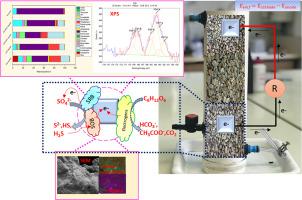Journal of Hazardous Materials ( IF 12.2 ) Pub Date : 2021-06-17 , DOI: 10.1016/j.jhazmat.2021.126417 Pratiksha Srivastava 1 , Rouzbeh Abbassi 2 , Asheesh Kumar Yadav 3 , Vikram Garaniya 1 , Trevor Lewis 4 , Yaqian Zhao 5 , Tejraj Aminabhavi 6

|
This investigation is the first of its kind to evaluate the interrelation of sulphate (SO42-) with conductive materials as well as their individual and synergetic effects on the removal of ammonium and organic pollutants in electroactive wetlands, also known as constructed wetland (CW) - microbial fuel cell (MFC). The role of MFC components in CW was investigated to treat the sulphate containing wastewater under a long-term operation without any toxicity build-up in the system. A comparative study was also performed between CW-MFC and CW, where sulphate containing wastewater (S-replete) and without sulphate wastewater (S-deplete) was assessed. The S-replete showed high NH4+ removal than the S-deplete, and the requesnce of removal was: CW-MFC-replete > CW-MFC-deplete > CW-replete > CW-deplete. The chemical oxygen demand (COD) removal was high in the case of CW-MFC-replete, and the sequence of removal was CW-MFC-replete > CW-MFC-deplete > CW-deplete > CW-replete. X-ray photon spectroscopic study indicates 0.84% sulphur accumulation in CW-MFC-replete and 2.49% in CW-replete, indicating high sulphur precipitation in CW without the MFC component. The high relative abundance of class Deltaproteobacteria (7.3%) in CW-MFC-replete along with increased microbial diversity (Shannon index = 3.5) rationalise the symbiosis of sulphate reducing/oxidising microbes and its impact on the treatment performance and electrochemical activity.
中文翻译:

硫与导电材料的相互关系及其对电活性湿地铵和有机污染物去除的影响
本研究首次评估硫酸盐 (SO 4 2- ) 与导电材料的相互关系,以及它们对电活性湿地(也称为人工湿地 (CW))中铵盐和有机污染物去除的单独和协同作用。 ) - 微生物燃料电池 (MFC)。研究了 MFC 组件在 CW 中的作用,以在长期运行下处理含硫酸盐废水,而不会在系统中产生任何毒性。还在 CW-MFC 和 CW 之间进行了比较研究,其中评估了含硫酸盐废水 ( S-replete ) 和不含硫酸盐废水 ( S-deplete )。的S-充满表现出较高的NH 4 +去除率高于S- deplete,去除要求为:CW-MFC- replete > CW-MFC-deplete > CW-replete > CW-deplete。CW-MFC-replete的化学需氧量(COD)去除率高,去除顺序为CW-MFC-replete > CW-MFC-deplete > CW-deplete > CW-replete。X 射线光子光谱研究表明,在CW-MFC-replete 中硫积累为 0.84%,在CW-replete 中为2.49% ,表明在没有 MFC 组分的 CW 中硫沉淀量高。班级相对丰度高δ-变形菌(7.3%)在CW-MFC-充满具有增加的微生物多样性(Shannon指数沿 = 3.5)硫酸盐合理化的共生还原/氧化的微生物和其上的处理性能和电化学活性的影响。









































 京公网安备 11010802027423号
京公网安备 11010802027423号